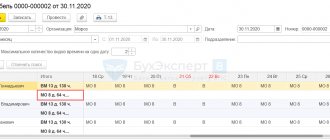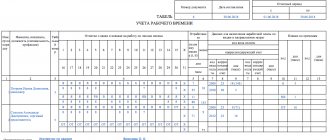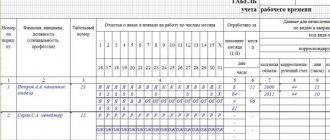Why is it needed and who fills it out in the organization?
A time sheet is a document that contains information about how many shifts and how many hours the employee actually worked during the month.
It also reflects all absenteeism, vacations and sick leave. A time sheet is required:
- Accounting - according to the time sheet, the employee’s salary is calculated monthly.
- Tax Service - when checking the correctness of payment of taxes that are withheld from wages, time sheets are used to reconcile data.
- Labor Inspectorate - it can check whether the employer is violating the rights of its employees.
The person responsible for maintaining time sheets is appointed by the head of the organization. For this purpose, a special order is issued. This is usually done by every department head. With a large staff of employees in an organization, a separate vacancy for a timekeeper may open.
The working time sheet is the primary document, which, according to the Labor Code of the Russian Federation, must be present at every enterprise, as stated in Article 91.
General rules for keeping timesheets
The accounting register must be opened on the first working day of the month, and it is drawn up from the first calendar day (even if the month begins on a weekend or holiday). At the end of the month the timesheet is closed. Some companies record interim results after the 15th, but only if production needs require it.
The key principles for maintaining this document must be declared in local regulations (for example, in the standard provision on time sheets). And the employee responsible for the time sheet must be guided by these regulations. Here it is worth clarifying and consolidating certain important points:
- The timesheet can be kept for individual structural divisions or for the company as a whole (the main thing is to determine this point immediately).
- The accounting must define coding by type of working/non-working time.
- The time sheet must reflect not only the hours worked, but also the time during which the employee did not carry out his work duties, although he should have done so (absenteeism, violation of labor discipline in the form of absence from the workplace, early leaving, downtime, etc.) .
- Each employee begins to appear on the timesheet strictly after it is registered in personnel records - there is an employment order, an employment agreement is signed. Similarly, employees are excluded from the time sheet - after the dismissal order comes into force.
- As soon as an employee is included in the time sheet, he is assigned a personnel number. Moreover, this number does not change throughout his employment in the company. If a person moves to another position, his personnel number remains the same. And even after an employee’s dismissal, his number cannot be assigned to anyone for another three years.
- Entering data into the timesheet in advance is strictly prohibited. It can only be filled in after the fact. Even if the timekeeper is sure, for example, that on the last day of the month everyone is already at work, it is not a fact that everyone will work the required 8 hours. Therefore, correct execution of the timesheet requires filling it out only the next day after a month has passed.
Methods for filling out the timesheet
There are actually 3 ways to maintain a timesheet:
- electronic;
- using automated accounting;
- on paper.
Of course, today the electronic method is used most often. Here you can always make adjustments, because there are often situations when the timesheet has to be corrected.
The most common simple accounting option today is to maintain a timesheet virtually manually in Excel. This method allows you to use entered formulas to calculate indicators, summarize them, and keep a timesheet throughout the year in a single file. Here you can keep statistics both for a specific employee, and for a division, and for the company as a whole. But still, this is a rather labor-intensive process for the timekeeper, which needs to be done regularly.
A more convenient and efficient way to maintain timesheets is to work through the 1C system. It also makes it possible to make adjustments to the electronic document. As a rule, internal online accounting is associated with a access system.
At large enterprises, even in order to go out for lunch, you need to check in, and the amount of time worked is automatically recorded in the time sheet
At large enterprises, especially in production, electronic systems for recording and monitoring employee working time are successfully used. Every second is recorded when an employee enters the enterprise and when he leaves. The most common types of such online surveillance include:
- electronic pass, when an employee, passing through the terminal, swipes a card, after reading the code on it, the information goes directly into the accounting program;
- there are terminals that can only be passed using a fingerprint (a more serious method, because the electronic card can also be given to another person for duty);
- retinal scanning - maximum degree of protection;
- video surveillance of workers, which allows, among other things, to monitor the production process itself;
- turning on and starting an employee’s work on a computer or going online or Skype (this is especially true for IT companies and Internet workers, including remote workers);
- recording telephone conversations (start/end) - for call center operators or online stores.
Such automated accounting allows you to eliminate the human factor and systematize the process.
Data from the online control system immediately enters the common database and forms a time sheet in real time. To the point that the immediate manager can see at any time: what time his subordinate came to work, what he did at the workplace and how many times he logged into social media. networks. Some systems allow you to generate an employee working time card.
The main thing here is that the use of any of the online control methods must be documented in the internal regulations, as well as in the labor contracts of employees. Only in this case is the use of any type of monitoring of the work process legal.
What is the difference between the T-12 and T-13 forms
To document time worked, unified forms T-12 and T-13 have been developed. The difference between them is that the T-12 form is placed on two sheets, every month after filling it is signed by the manager and submitted to the accounting department for payroll calculation.
As for the T-13 form, it is completed electronically in a special program in which all the necessary data and details have already been entered. At the end of each month, a form is created and printed. Afterwards, the document is certified by the manager and submitted to the payroll accountant.
How are working hours recorded?
The time sheet is maintained to perform a number of functions:
- control of working and non-working time;
- checking compliance with the work schedule by recording lateness and absences for various reasons;
- calculation of earnings for employees of the enterprise, proof of the correctness of calculations;
- obtaining information for the necessary reporting;
- the basis for imposing disciplinary sanctions on an employee due to violation of the work and rest regime.
The timesheet contains information about the days actually worked by employees.
Important! The form developed by Goskomstat is not mandatory, but is recommended for use. Employers, if necessary, have the right to develop the form themselves and use it in their work.
A unified form (T-12 or T-13) implies the reflection of information on recording visits to the enterprise for each employee. The title page of form T-12 contains information about all designation codes that are used when filling out the timesheet.
The two types of codes (alphabetic and numeric) are used equally. In addition, the local acts of an enterprise may stipulate the use of a mixed type of filling out a document, as well as other proprietary designations.
Step-by-step instructions for filling out the timesheet
There is nothing difficult in filling out the timesheet form, since all lines and columns have designations of what information should be contained in them.
First of all, you need to fill out the header of the document:
- Name of company.
- The name of the structural unit in which the employees work.
- OKPO code.
- Document number in order.
- Date of preparation of the timesheet. The last day of the month must be entered here. Reporting period, that is, the first and last day of the reporting month.
After filling out the header of the document, you can start creating the tabular part:
| Column no. | What information is contained |
| 1 | serial number |
| 2 | the surname and initials of the employee are indicated, as well as the position held by him |
| 3 | employee personnel number |
| 4 | information for each calendar day, which shows whether the employee was present at the workplace, how many hours were actually worked |
| 5 | how many days and hours were worked each half of the month |
| 6 | how many days and hours were worked for the entire month |
| 7 | code corresponding to the reason for which funds are accrued |
| 8 | corresponding accounting account corresponding to the item on the basis of which the accruals were made |
| 9 | the number of days or hours is indicated in accordance with the specified classification code |
| 10 | code corresponding to the reason why the employee did not show up to the workplace |
| 11 | days or hours that the employee was absent |
After filling out the table, the lines for signatures are located:
- responsible person - position, signature, transcript;
- head of the structural unit - position, signature, transcript and date;
- HR department employee - position, signature, transcript and date.
The procedure for maintaining a document is presented in detail in the video.
How to fill?

The timesheet is filled out daily during the calendar month. At the end of this period, the number of hours worked by each employee is calculated. When calculating wages, employee absences are taken into account and are also entered on the form.
What documents are needed to open an individual entrepreneur? Would you like to know the complete list? How to open an online store from scratch? We invite you to receive a response.
A sample power of attorney to receive goods is presented in the article at the link below. https://101million.com/dokumenty/doverennosti/na-poluchenie-tovara.html
Both standard forms contain the same set of details and symbols, so the principles for filling them out are the same. The forms are placed on both sides of the sheet in a book arrangement. Section 1: working time tracking.
The header of the document must indicate:
- name of the enterprise along with the legal form (IP, LLC, OJSC, and so on);
- OKPO code;
- reporting period (from the first to the last day of the month);
- Document Number.
The “Document date” cell is filled in on the last day before sending it for approval by the manager.
The 1st column of the accounting table contains the serial number of the employee, starting from one.
2nd column - the last name and initials of each employee along with their position. This data is taken from the personal cards of employees in the T-2 form. The order of entry is not strictly defined, but most often names are entered alphabetically or by personnel number, which fits into the adjacent 3rd column.
The 4th and 6th columns are the main part of the document, in which numerical or alphabetic symbols of hours worked for each day are entered. The top line is used to enter codes, the bottom line is used for hours. In the T-13 form, both halves of the month are noted in column 4, then the number of lines for each employee doubles.
5th and 7th - interim results for the first and second half of the month, respectively.
The remaining columns of the table from 8 to 17 are filled in at the end of the period on the basis of supporting documents (sick leave, orders, explanatory notes):
- 8-13 - number of days (top line) and hours (bottom line) with a separate calculation of overtime hours and time worked on holidays and at night;
- 14-16 — number of no-shows indicating the reason code;
- 17 is the sum of days off for the month.
Section 2: settlements with personnel.
This part of the table is located on page 3 and contains the type of payment and correspondent account; it is filled out by the accounting department based on the “Chart of Accounts”. In the T-12 report card, if these parameters are the same for all employees, the settlement department employee fills out columns 18-22, and if each employee uses different types of payment, the necessary codes and numbers are inserted into columns 18-34.
Columns 35-55 contain statistical information for each employee and the final performance indicators of the department for the month: the number of man-days and man-hours, the number of employees, and so on.
In the T-13 sheet, which is filled out automatically based on information from the accounting program, columns 7-9 must be filled out in the first case and column 9 in the case of applying several tariff rates.
How to reflect vacation
Before recording an employee’s vacation on a time sheet, it is necessary to determine its type:
- Regular leave, which is due to each employee annually, is designated OT or OD.
- Without pay - an employee has the right to take several unpaid days of leave necessary for personal reasons, designated OZ or DO.
- Training - the employee may not attend work during the session, he is issued paid leave, code U.
- For pregnancy and childbirth - designated as R.
- For child care - this period is also considered vacation, designation code is coolant.

When recording vacation days in the timesheet, the code corresponding to the situation is entered daily, but the hours are not indicated.
Features of using codes in the report card
The report card uses codes in the form of large letters, for example NZ, VP, RP, I, etc., for each situation there is a numerical code. There are 35 alphabetic and numeric codes in total. The most common are:
- Work during the day, standard 8 hours – I, number 01.
- Night shift – N, 02.
- Exits on holidays, non-working days, weekends - RV, 03.
- Work beyond the norm - C, 04.
- Being on a business trip – K – 06.
- Planned vacation – FROM, 09.
- Maternity leave – P, 14.
- Sick leave when confirmed by documents – B, 19.
- Absence without good reason (truancy) – PR, 24.
- Day off – B, 26.
- Strike – ZB, 29.
- Absence for unknown reasons – NN, 30.

Features of using codes:
- The NN code is used in any case when the employee is not on site and it is not known why. Even if there is a suspicion that he is skipping work, there is no need to rush to mark this code. If the employee, upon appearing on site, provides a certificate that he was absent for a valid reason, corrections will have to be made.
- Code B, that is, sick leave is issued for the entire period of absence, which is confirmed by a sick leave certificate. Applies to weekends and workdays.
- When on regular vacation, weekends and holidays are marked as such.
- It is allowed to use either alphabetic or numeric designations in the report card.
How to fire an employee without his consent according to the law?
Double encoding
Situations arise when entering only one code does not reflect the actual operating state. Example: a woman is on maternity leave, but is ready to work at ½ rate. It is impossible not to mark any of the codes.
Designations and codes in the tabular part of the document
In order to avoid recording a large amount of information, unified codes and designations were established.
Basic wage codes:
| Code | Description |
| 2000 | salary (including remuneration and bonuses) |
| 2012 | vacation pay |
| 2300 | sick leave payment |
| 2760 | payment mat. assistance during retirement or after dismissal |
Codes indicating the presence of an employee at work:
| Code | Description |
| I | presence at work |
| N | night work |
| RV | work on weekends and holidays |
| WITH | overtime work |
| VM | shift work |
Regarding being on a business trip:
| Code | Description |
| TO | business trip |
| PC | business trip related to professional development |
| PM | business trip related to advanced training, sending an employee to another location |
The absence of an employee for various reasons is indicated:
| Code | Description |
| B | being on sick leave, with pay |
| T | sick leave without pay |
| Champions League | shortened day |
| UV | part-time due to combination with study leave |
| ETC | absenteeism |
| PV | forced absenteeism |
| G | the employee is absent due to the performance of government duties |
| IN | day off |
| OB | additional day off, paid |
| NV | additional day off, not paid |
| NN | no information due to absence |
| NZ | work stoppage due to delayed wages |
| RP | downtime of the production process due to the fault of the employer |
| VP | downtime of the production process due to the fault of the employee |
| NP | production downtime for other reasons |
| ZB | strike |
| BUT | removal of an employee from work for any reason is paid |
| NS | part-time work |
| OD | administrative leave, unpaid |
| OZ | statutory leave, unpaid |
Corrective report card - what is it for, design nuances
Perhaps every timekeeper who has been keeping personnel records for an enterprise for at least a couple of months has been faced with the need to make adjustments to an already signed document. In these and many other options, an additional time sheet is drawn up - a corrective one.
The form of such a document is no different from the primary one, except for one point - the header indicates that the document is corrective. This timesheet is also assigned a serial number, and the primary timesheet is not taken into account.
Recommendation for the timekeeper: when making an adjustment, attach a memo to the timesheet in which you describe the reasons for making clarifications to the primary report, and also supplement your words with copies of documents confirming the need to make adjustments.
2 ways to prepare an adjustment sheet:
- duplicate data in the timesheet that does not need to be changed, and adjust only a certain block;
- draw up a report card showing only the changed codes.

A correction sheet can be generated from a previous file - just enter the correction code and number, change the date of compilation and the data in the table
Life situations - how to fill out the report card
Each mark on the report card entails not only a monetary reward or, on the contrary, punishment, but can also lead to the dismissal of a person. Therefore, some situations must be recorded in separate internal or external documents, and only after that they can be reflected in the accounting documentation. This includes reports and official notes, orders, acts, certificates of incapacity for work, etc.
The employee did not show up for work - the reason is unknown
It happens that an employee does not come to work and does not inform his immediate supervisor. The first, most natural step would be to call the person and find out the reason. Well, if the question remains open, the head of the structural unit where the employee is registered is obliged to write a report and prepare a corresponding act stating that the person is absent from the workplace. The document is endorsed by two witnesses. During this period, until the circumstances of the absence from work are clarified, the code “NN” (failure to appear for an unknown reason) is entered on the report card.
As soon as the employee went to work or reported the reason by phone, if it was not a sick leave, he is asked to provide an explanatory note, where he must explain the reasons for his absence from the workplace. If the fact cannot be considered satisfactory, an o is written on the report card, and the employee may be fired for this.
Reflection of the certificate of incapacity for work during vacation
Labor legislation recognizes that if an employee falls ill during vacation, the employer is obliged to extend his vacation by the number of days specified in the sick leave, or shift unused vacation days to another time. Therefore, it is important to determine and enter into the time sheet the days when the employee had a blank sheet. And for this, the timekeeper must have a document confirming the person’s incapacity for work. As soon as the b/sheet is provided, adjustments are made to the time sheet, where the days when the person was healthy while on vacation are marked with the abbreviation “OT” (vacation). And the days for which there is sick leave, respectively, are “B”. Extended leave immediately after illness. And if a person postpones a vacation that was not taken “for later,” these days will be recorded in another report card.
Business trip on a day off
When an employee goes on a business trip and one of the days falls on a day off, this day is considered a working day (even if the person did not work on this day, for example, he was on the road). Therefore, this day should also be listed as standard on the report card (business trip). And when an employee is delayed on a business trip or his flight is postponed, he has to make an adjustment accounting document.
Management in budgetary organizations
In budgetary organizations it is also necessary to keep track of working hours. The only difference in its management is that designations corresponding to the type of activity are added:
| Code | Description |
| VU | study weekend |
| ZN | substitution in primary grades (from 1 to 3) |
| Salary | substitution in after-school groups |
| ZS | replacement in high school (from 4 to 11) |
| OU | additional study leave |
Working hours are also recorded on a monthly basis; the document is created 3 days before the start of the period and, at the end of the period, is submitted to the accounting department for calculation.
The header of the document indicates not only the name of the organization, but also the corresponding digital code.
Fines and liability
Maintaining a time sheet is mandatory for any enterprise, therefore, improper fulfillment of this duty or its complete absence may result in punishment.
In this case, a violation of labor laws will be recognized. The person responsible may be reprimanded if this happens for the first time. If a violation is detected again, a fine of 1000 rubles is imposed. up to 5000 rub. As for the organization, it faces a fine of 30,000 rubles. up to 50,000 rub.
Maintaining a timesheet is necessary not only at the level of responsibility, it, first of all, facilitates the calculation of wages for each employee and allows you to avoid controversial issues in this matter. Therefore, recording the actual time worked must be taken seriously.
Documents for download (free)
- Sample form T-13
- Sample form No. T-13
- Sample form No. T-12








